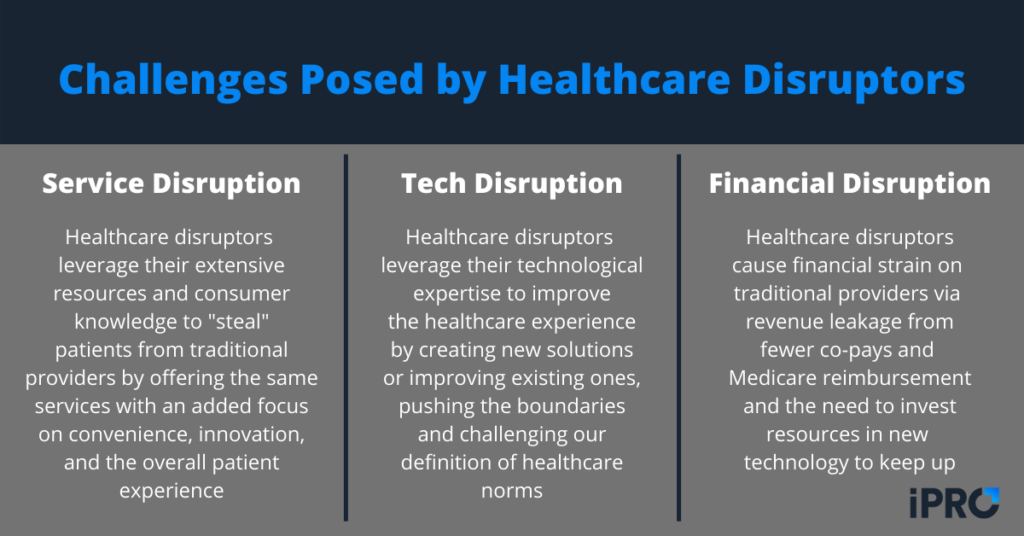Healthcare disruptors are changing the healthcare landscape, just as their name suggests. By offering innovative, consumer-centric healthcare services, healthcare disruptors offer patients new ways of experiencing healthcare when and where they want. This poses a significant challenge for traditional healthcare providers – hospitals, clinics, imaging centers, etc.
In this article, we’ll take a look at who healthcare disruptors are and what they do, some of the major challenges they present for hospitals and other traditional healthcare providers, and ways to disrupt the disruptors.
Healthcare Disruptors: Who They Are and What They Do
What makes a company a healthcare disruptor? Becker’s Healthcare asked 12 healthcare innovation executives that very question in 2020. For Aaron Martin, EVP and Chief Digital Officer of Providence, “disruption is a competing business model that puts the existing incumbent model at a disadvantage.” Chris Coburn, Chief Innovation Officer at Mass General Brigham believes healthcare disruptors’ goal is to dominate and improve health. Coburn believes disruption consists of at least one of the following:
- Enhanced efficiency
- More effective treatment/curing of disease
- Reduced costs for consumers
- Expanded access of healthcare services
- Accelerating the treatment/diagnosis of an illness at a stage, price, or mode previously impossible or impractical
Essentially, healthcare disruption challenges the healthcare status quo to provide better outcomes for consumers through innovation. These outcomes may be in the form of increased access and/or affordability, better treatment, and an overall improved patient (or consumer) experience. Ultimately, healthcare disruptors are good for patients, but a threat for providers. Now that we have an understanding of what healthcare disruption is, let’s take a look at some of the industry’s biggest disruptors and what they are doing.
Major Healthcare Disruptors
While many companies may be considered a “healthcare disruptor,” let’s focus on the biggest and most well-known companies disrupting healthcare:
- Amazon
- Apple
- CVS
- Walgreens
- Walmart
Amazon: The world’s largest online retailor is disrupting healthcare in several ways, such as their Amazon Halo wearable activity tracker and app and a national telehealth service for large employers called Amazon Care. They are also offering prescriptions through Amazon Pharmacy and plan to offer in-home visits for blood draws and more.
Apple: Like Amazon, Apple is also in the wearable healthcare devices market. Apple’s EHR initiative, “Apple Health Records,” is now supported by over 500 U.S. institutions and generates innovative insights by combining patient EHR data with health and activity information captured by the patient’s Apple devices. Additionally, Apple has been acquiring companies, such as AI image recognition startup Xnor.ai that the company could incorporate into a bigger healthcare push.
CVS: Already a consumer healthcare company, CVS is expanding its healthcare footprint by opening over 600 HealthHUBs – stores which feature expanded health clinics and labs for blood testing. CVS HealthHUBs are one of the most direct forms of competition traditional providers face from healthcare disruptors.
Google: Google is focusing on a broad range of healthcare initiatives, from its Fitbit wearable devices to FHIR software development tools for healthcare providers. One of Google most notable healthcare initiatives is the integration of its EHR search tool, Care Studio, into Meditech’s EHR platform. While Google is disrupting healthcare, some of the company’s initiatives can actually benefit hospitals and other traditional providers.
Walgreens: Like their own competitor CVS, Walgreens is entering the medical clinic space by partnering with primary care provider VillageMD to open over 500 full-service clinics that are integrated with Walgreens’ pharmacies. The clinics will mostly be opened in areas with provider shortages and offer 24/7 telehealth services.
Walmart: The king of brick-and-mortar retail, Walmart’s entrance into healthcare may be particularly concerning for providers. The retail giant continues to open Walmart Health supercenters for dental and primary care services. Additionally, Walmart has become a fully licensed insurance broker. The company also plans to offer specialty services, such as imaging, with the goal of Walmart Health locations becoming a one-stop-shop for healthcare, just as Walmart Supercenters are for consumer goods.
Challenges Healthcare Disruptors Pose
Now that we’ve looked at who the major healthcare disruptors are and how they’re disrupting healthcare, let’s take a look at some of the challenges they pose for traditional providers.
Service Disruption
The most obvious and troubling challenge healthcare disruptors present is service disruption – taking away services from hospitals, physician practices, and other traditional healthcare providers. Retail companies like Amazon, Walmart, CVS, and Walgreens have decades of experience in delighting customers, giving them an advantage over traditional providers in the area of patient (or consumer) experience. Providing in-person care via health clinics (Walmart, CVS, and Walgreens) could draw patients away from traditional providers due to the convenience of being able to pick up prescriptions and/or medical supplies at the same location they received their healthcare visit.
Amazon’s in-home visits are not only convenient, but can also provide care to those in under-served areas. Additionally, Amazon’s ability to integrate patients’ healthcare data from its wearable devices into the care plan can create a seamless experience. In traditional settings, sharing this data with a physician or other medical staff may be complicated due to a lack of interoperability. The trust and loyalty traditional providers have fostered with their patients will be tested by the convenience offered by retailors.
Tech Disruption
Tech companies like Apple and Google can provide challenges to traditional providers through disruptive technologies. As mentioned earlier, both companies have already entered the EHR space. While Apple and Google’s EHR initiatives could benefit traditional providers with improved efficiency and greater insights, the tech giants could also use them to grow their own healthcare footprints. Years ago, the idea of retailers like Walmart and Amazon offering in-person healthcare seemed farfetched, but here we are. Apple and Google could certainly enter the fray as well, and their extensive history of tech innovation could lead to even more disruption for healthcare providers.
Financial Disruption
The effects of service disruption and tech disruption culminate in a third major challenge for healthcare providers – financial disruption. As healthcare disruptors steal patients from hospitals and physicians, revenue leakage becomes a serious problem. Particularly, traditional providers receive fewer co-pays and Medicare reimbursement. Tech disruption forces traditional providers to invest more money in new tech to ensure their offerings are competitive with the disruptors. Since healthcare providers’ main focus is on treating patients, it may seem like they’re constantly playing catch-up to retail and tech giants in regards to innovative offerings and technology.
For tips on recovering revenues and stopping leakage, check out our blog on the topic.

Disrupting the Disruptors
Now that we know who the disruptors are and how they disrupt healthcare, the big question is “how do we disrupt the disruptors?” Let’s take a look at some strategies healthcare providers can take to remain competitive with disruptors.
Strengthen Relationships with Referring Providers
One way to stop healthcare disruptors from stealing your patients (and revenues) is to strengthen your relationship with referring providers. You can bet that healthcare disruptors like Amazon, Walmart, CVS, and Walgreens will be focusing on physician referrals to bolster their new healthcare initiatives. While these disruptors may compete with physician clinics, they could also form partnerships with them to gain referrals. If your relationship with your physician community isn’t that strong, these physicians may refer patients to these big name retailers for a variety of reasons:
- Strategic partnerships with retailers
- Convenience for patients (i.e. picking up prescriptions/supplies at the same location)
- Perceived trust/reliability of the brand
So, how can hospitals strengthen their relationship with referring providers? Here are a few ways:
- Attend healthcare conferences to take advantage of networking opportunities
- Invest in solutions that make physicians’ jobs easier, such as Clinical Decision Support (qCDSM), Medical Necessity Validation, and Clinical Workflow Automation
- Focus on improving or maintaining high quality scores
Maintaining a strong relationship with referring providers actually aids in our next strategy for combating healthcare disruptors…
Create an Exceptional Patient Experience
As we mentioned earlier, healthcare disruptors like Amazon and Walmart have an advantage over traditional healthcare providers when it comes to delighting consumers. They make it a priority to know what people want, and they adapt their offerings to meet those wants. Their entry into the healthcare space is a prime example.
Traditionally, if patients weren’t happy with a healthcare experience, they may see a new provider or request their provider refer them to a different specialist. With the emergence of healthcare services from trusted retailers, patients now have the option of taking their business to a company they know provides a great consumer experience. Trust is key in healthcare. While patients may trust their healthcare to traditional providers at first, a trusted consumer brand name coupled with the convenience of a one-stop-shop or integrated health data may convince them to make the switch if they’re unhappy. This is why it’s so important for traditional healthcare providers to create an exceptional patient experience.
Here are some tips for creating a patient experience that fosters loyalty in the fight against disruptors:
- Focus on the patient as a customer and treat them as a partner in their care, encouraging discussion and feedback
- Empower patients to take control of their healthcare through digital tools, such as self-scheduling and payment apps
- Invest in a strong digital front door to aid in patient empowerment and the overall patient journey
- Provide patients with resources such as procedure-specific instruction videos, appointment reminders, and navigation assistance to minimize treatment delays due to improper preparation/no-shows
Learn how improving your patient scheduling process can improve your bottom line in our new ebook.
How We Can Help
Healthcare disruptors are a major threat to hospitals due to their innovation, reputation, and focus on consumers’ wants and needs. In order to compete with these disruptors, hospitals must adopt the same mentality. Two major areas of focus for hospitals hoping to compete with disruptors are their relationship with referring providers and the customer experience. At iPro, we have a solution that can help hospitals improve in both of these areas: iOrder ambulatory order management.
iOrder generates a digital patient order that provides complete transparency, eliminates the fax machine and lost orders, and alleviates clinical workloads. iOrder’s integrated Clinical Decision Support Mechanism (qCDSM) and prior authorization services can strengthen your relationship with referring providers by streamlining ambulatory workflows, saving time on each order, and maximizing reimbursements. iOrder also empowers patients by providing them with automated appointment reminders, links to procedure prep videos, and GPS navigation to the facility.
If you’d like to learn more about how iOrder can help you disrupt the disruptors, contact us or schedule a free live demo today.





